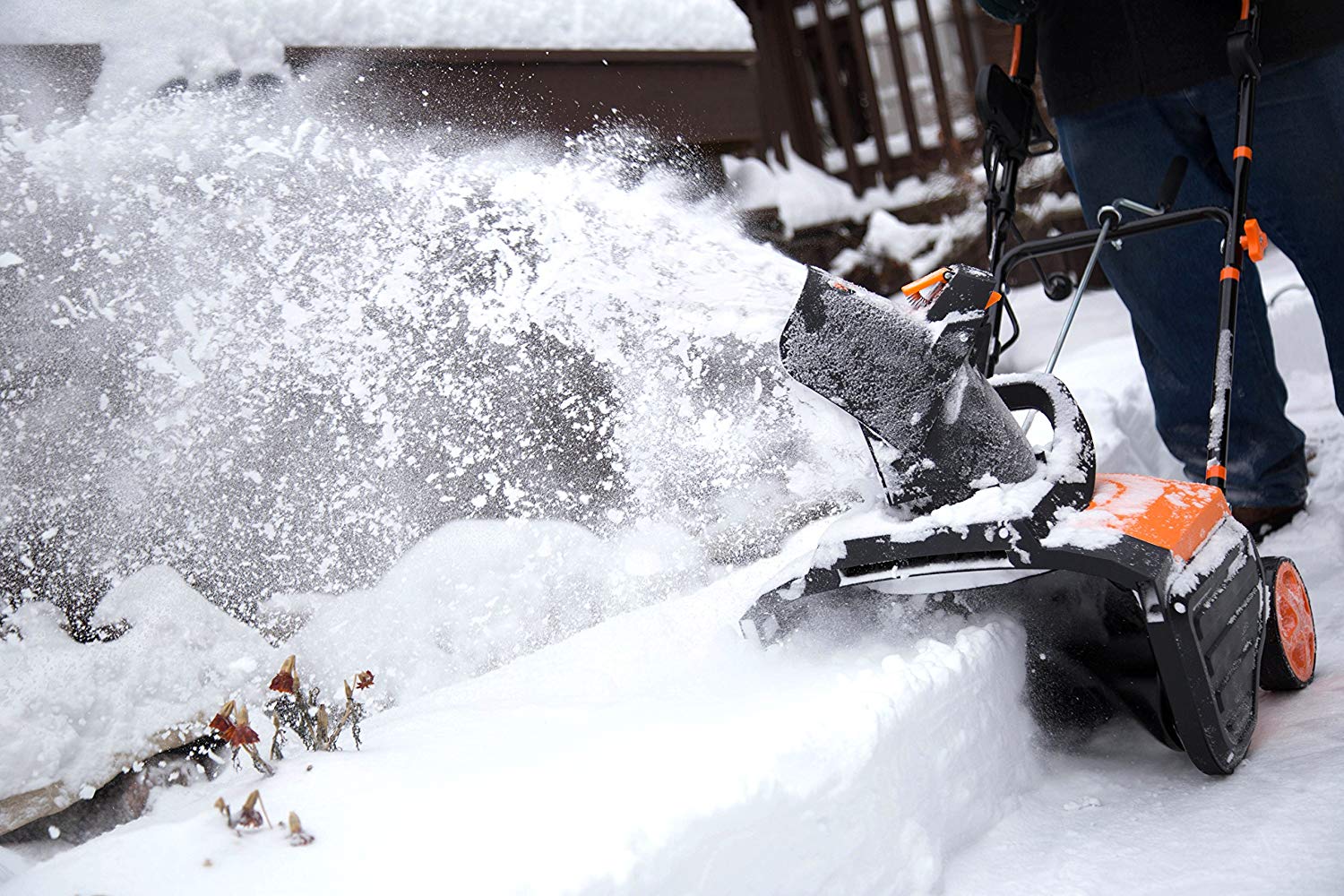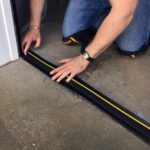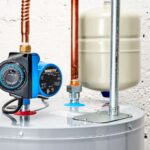Cordless snow blowers are a relatively new tool that are gaining popularity as an alternative to traditional gas-powered models. They provide a convenient, quieter, and more environmentally-friendly way to clear snow.
Cordless snow blowers run on rechargeable lithium-ion batteries and electric motors instead of gas engines. This makes them lighter, easier to start and maintain, and eliminates the need to store and handle gasoline. Their quiet operation allows you to clear snow early in the morning or late at night without disturbing neighbors.
The main downside is reduced runtime compared to gas models. However, most cordless blowers can run for 30-45 minutes on a single charge, which is sufficient to clear a typical driveway or sidewalk. Runtime can be extended by purchasing additional batteries.
Cordless blowers also tend to be less powerful than gas-powered equivalents. But modern battery technology enables them to handle moderate snowfalls up to 6-12 inches. Heavier wet snow may require multiple passes.
Overall, cordless snow blowers are a great option for many homeowners who value convenience and don’t need to clear large areas of heavy snow. The lack of engine maintenance and emissions make them simpler and cleaner to operate. Just be mindful of battery life when working.
Table of Contents
How Cordless Snow Blowers Work
Cordless snow blowers run on rechargeable lithium-ion battery packs that power an electric motor. This allows them to operate without being tethered to an electrical outlet or needing gasoline. The battery and motor technology has improved greatly in recent years, allowing cordless models to rival gas-powered blowers for runtime and power.
Battery
The battery is the power source for the motor. Higher capacity batteries, measured in amp hours (Ah), allow for longer runtime before needing to be recharged. Top cordless snow blowers today use large batteries, usually between 40V to 80V and 5Ah to 12Ah. These lithium-ion batteries are lightweight yet store plenty of power.
Motor
Cordless snow blowers use a brushless electric motor rather than a gas engine. Brushless motors have improved efficiency over brushed motors, providing more torque and faster speeds while using less power. They also have a longer lifespan with less maintenance needed. The motor converts the battery’s electrical energy into mechanical power to drive the auger and impeller to throw snow. More powerful motors around 3-4HP can clear snow quickly.
Runtime
Runtime is determined by the battery capacity and efficiency of the motor. Large batteries around 10Ah to 12Ah can typically provide 30 to 45 minutes of max runtime. This is enough to clear a full driveway or sidewalk for most homes on a single charge. Runtime will be less when working in thick or heavy snow. Batteries can be charged in 1-2 hours.
Power
With high capacity batteries and motors over 3HP, cordless snow blowers now rival gas models in power. They can throw snow up to 30 feet and handle up to 18 inches depth of lighter snow. Heavier snowfalls may require multiple passes. Powerful cordless blowers work well for most residential use, only lacking behind commercial duty gas models.
Key Features to Look For
When shopping for a cordless snow blower, there are a few key features to consider that will determine how powerful, easy to use, and effective the snow blower will be.
Power and Runtime
The power and battery runtime are important factors that determine how quickly and for how long you’ll be able to clear snow before needing to recharge. Look for snow blowers with high voltage lithium-ion battery packs, usually between 40V – 80V. Higher voltage means more power and torque to handle heavy, wet snow. Also check the runtime per charge – aim for at least 30 minutes, with an extra battery for more clearing time.
Clearing Width
The width of the snow blower’s intake determines how much snow it can handle in a single pass. Wider clearing widths of 18-24 inches are best for tackling large driveways and walks efficiently. Make sure to choose a width that aligns with the size of the areas you need to clear.
Handling and Maneuverability
Since cordless snow blowers are lighter than gas models, they tend to be easier to maneuver and control. Look for compact, single-stage designs with adjustable handles and intuitive controls. Wheels that swivel and trigger steering also improve handling in tight spaces. Seek out models with features that make the snowblower easy to use and transport.
Top Picks
When choosing a cordless snow blower, here are some of the top models to consider:
EGO Power+ Snow Blower
The EGO Power+ Snow Blower is one of the highest rated cordless models on the market.
Pros:
- Powerful brushless motor provides excellent snow clearing performance
- Large 21-inch clearing width
- LED headlights for seeing in low light
- Up to 60 minutes of max runtime on a single charge
Cons:
- Heavy and bulky design
- Expensive
Greenworks Pro Snow Blower
The Greenworks Pro offers a more budget-friendly cordless option.
Pros:
- More affordable price point
- Decent 20-inch clearing width
- Brushless motor for good power
- Up to 45 minutes of runtime
Cons:
- Not as powerful as the EGO model
- Shorter runtime
Ryobi Snow Blower
The Ryobi is a good mid-range cordless snow blower choice.
Pros:
- 18-inch clearing width
- Brushless motor with good power
- Up to 50 minutes of max runtime
- More budget-friendly than the EGO
Cons:
- Smaller clearing width than other models
- Mixed reviews on long-term durability
When picking between these options, factors like clearing width, power, runtime, and budget will help determine the best cordless snow blower for your needs. The EGO Power+ is the premium choice, while the Greenworks Pro and Ryobi offer more affordable options.
EGO Power+ Snow Blower
The EGO Power+ Snow Blower is one of the top cordless models on the market today. It offers excellent power and runtime thanks to the 56V ARC Lithium battery system. Here are some key specs and features of this snow blower:
- Clearing Width: 21 inches
- Intake Height: 13 inches
- LED Headlights: Yes
- Battery: 56V ARC Lithium (2.5-5.0 Ah)
- Charging time: 2 hours (fast charger)
- Runtime: Up to 45 minutes (2.5 Ah)/ 60 minutes (5.0 Ah)
- Weight: 47 lbs
Pros
- Powerful brushless motor provides gas-like power
- Variable speed settings from 1100 to 2000 RPM
- Electric start button for easy start up
- Self-propelled model available for extra convenience
- Quieter operation than gas snow blowers
Cons
- Battery and charger sold separately
- Shorter max runtime compared to gas models
- Heavier than some other cordless options
The EGO Power+ offers excellent power and performance to handle moderate to heavy snowfall. The variable speed auger allows you to match power to conditions. While the runtime is shorter than gas models, the fast charger helps make up for this. Overall, it’s one of the top cordless snow blowers for those needing serious snow clearing performance without the hassles of gas.
Greenworks Pro Snow Blower
The Greenworks Pro 80V cordless snow blower is a great mid-range option for those needing to clear light-to-moderate snowfall.
Specs:
- 80V lithium-ion battery
- Up to 45 minutes of runtime
- 20 inch clearing width
- 10 inch clearing depth
- Throws snow up to 30 feet
Features:
- Brushless motor for increased power and longer life
- LED light for visibility in dark conditions
- 180 degree rotating chute
- Push button start
- Variable speed settings
Pros:
- Powerful enough for most residential use
- Good runtime for moderate snowfall
- Electric start is convenient
- Rotating chute provides flexibility
- Relatively lightweight at 37 pounds
Cons:
- May struggle with heavy, wet snow
- Runtime less than higher-end models
- No heated handles or treads
- Not designed for commercial use
Overall, the Greenworks Pro provides a nice balance of power and price for most homeowners needing a cordless electric snow blower for typical snow events. It’s a good step up from lower-end models without the cost of pro-level blowers.
Ryobi Snow Blower
The Ryobi 18-Inch 40-Volt Cordless Snow Blower is a great mid-range option for homeowners looking for an electric snowblower. Here are the key features and specs:
- 40V lithium-ion battery provides up to 45 minutes of max runtime
- 18-inch clearing width
- Up to 430 lbs per minute snow throwing capacity
- LED headlights for visibility in low light conditions
- Adjustable chute rotates 180 degrees with remote crank control
- Push button electric start
- Brushless motor technology provides high efficiency and performance
- Weighs only 38 lbs for easy maneuverability
Pros
- Excellent runtime for a cordless model
- Powerful brushless motor can handle moderate snowfalls
- Lighter weight than gas models
- Easy push button start with no pull cords
- LED headlights are handy feature
Cons
- Battery and charger sold separately
- Clearing width on the smaller side
- Not designed for heavy, wet snowfalls
- Chute adjustment lever could be smoother
Overall, the Ryobi 40V snow blower provides a solid cordless option for light-duty use. The generous 45 minute runtime, brushless motor, and push button start make it a worthwhile investment for small driveways and walkways. Just be mindful of its limitations with heavy snow.
Tips for Using a Cordless Snow Blower
Charging and Battery Care
- Always fully charge the battery before first use and after each use. Most cordless snow blowers take 2-3 hours to fully charge.
- Don’t leave the battery sitting in storage for long periods without recharging. Charge at least every 3-4 months to maintain optimal battery life.
- Store the battery indoors, away from extreme cold or heat. The ideal storage temperature is around 70°F.
- Check the user manual for battery storage and charging recommendations specific to your model. Generally, lithium-ion batteries prefer partial over full discharges.
- Consider investing in a backup battery so one can be charging while the other is in use. Extra batteries greatly improve runtime.
Operating Tips
- Let the snow blower do the work, don’t force it through deep snow. Go slowly for better results.
- Adjust the chute direction to avoid blowing snow onto cleared surfaces. Throw snow downwind when possible.
- Don’t use the snow blower to clear gravel or rocky surfaces which can damage the auger.
- Dress warmly in layers and wear boots with good traction to avoid slips.
- Keep hands and feet away from the auger while operating. Don’t attempt to clear jams with your hands.
- Cordless snow blowers are ideal for smaller tasks like decks, walkways and driveways. Use a gas model for big jobs.
- Monitor battery level to avoid running out mid-job. Have a backup battery or charger nearby.
- Wipe off snow and ice from the exterior after each use to prevent buildup and clogging.
Cordless vs Gas Snow Blowers
Cordless and gas-powered snow blowers each have their own pros and cons to consider. Here’s how they compare:
Cost
- Cordless snow blowers are generally more affordable upfront, with prices ranging from $200-$500 for a decent model. The batteries and chargers add to the cost, but you avoid gas and oil costs over time.
- Gas-powered snow blowers have a higher upfront investment, typically $600 on the low end up to $1,500 or more. However, you don’t have to pay for batteries and chargers.
Performance
- Gas snow blowers offer more power and can handle heavy, wet snow with ease. They can work for 1-2 hours or more on a single tank of gas.
- Cordless models have improved in power, but runtime is limited to 30-60 minutes per charge. They can struggle with heavy snow over 6 inches deep. Better for light snowfalls.
Maintenance
- Cordless snow blowers just need the batteries and augers maintained. No oil changes, spark plugs, fuel stabilizers, etc.
- Gas snow blowers require regular maintenance like oil changes, spark plug replacement, carburetor cleaning, fuel stabilizers to prevent gumming. More involved.
Convenience
- Cordless snow blowers are very convenient. No trip to the gas station for fuel. Just charge up and go. Quieter too.
- Gas models require getting gas and oil. Have to maintain proper fuel/oil mix. Pull-starting can be a hassle. Louder operation.
Emissions
- Cordless models have zero emissions, better for the environment.
- Gas snow blowers produce emissions that pollute the air. Have to properly dispose of oil.
In summary, cordless snow blowers win for convenience and cost, while gas models offer more power and longer runtime for heavy snow removal. Consider your needs and budget.
Conclusion
Cordless snow blowers provide a convenient and eco-friendly alternative to gas-powered models. Their lightweight, quiet operation and lack of fumes make them ideal for most residential snow removal needs.
When shopping for a cordless snow blower, prioritize runtime, clearing width, and battery voltage. Models with 60V+ batteries and 20-inch+ widths offer the best power and efficiency for most users. Stick with reputable brands like EGO, Ryobi, and Greenworks that offer good warranties and proven cold weather performance.
For most homeowners, a medium-duty cordless snow blower like the EGO Power+ or Greenworks Pro will provide ample clearing power without the maintenance of gas. Only those tackling large driveways or commercial use may require a heavy-duty gas snowblower.
Cordless snow blowers do have limitations on runtime versus gas models. But backup batteries can extend running time as needed. And provided you don’t let snow accumulate extensively, a single charge should suffice for a typical driveway or sidewalk.
With the right cordless snowblower, you can clear snow quickly, quietly, and emissions-free. Just be sure to select a model with sufficient power and features to match your specific needs.



